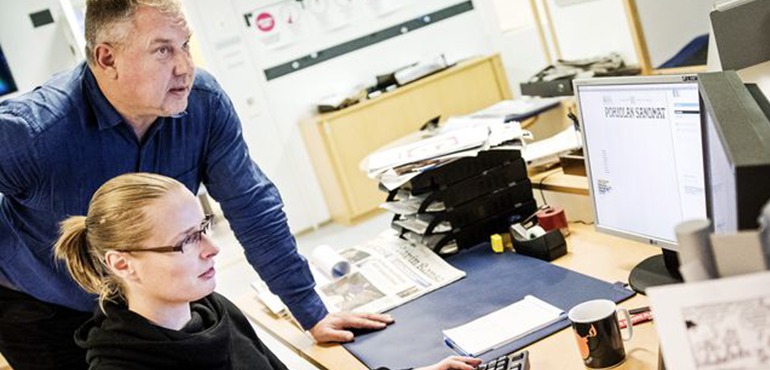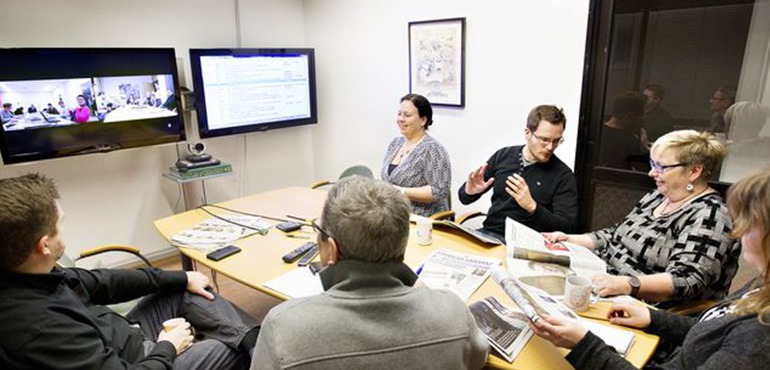
The best of both newspapers
Six months have passed since Pohjolan Sanomat and Lapin Kansa merged.
“We spent a lot of time considering how to make our newspaper business in Lapland more cost-efficient. We carefully weighed up the options and made calculations. ‘Together we’re stronger’ is an accurate slogan; both newspapers had their problems, and even Lapin Kansa was under huge pressure to cut costs,” says Lapin Kansa’s Editor-in-chief, Antti Kokkonen.
The idea was to retain the brand of both papers so that subscribers would receive the same paper as before. They have shared content except for the cover and a few pages.
“Customers don’t notice any major changes, as they still see the old brand that they are used to and fond of.”
Operations are run from Rovaniemi
The news desk at Pohjolan Sanomat was closed as a result of the merger, and the operations are run from Rovaniemi. The Pohjolan Sanomat editorial office was turned into a regional office.
The news desk is now located in Rovaniemi. Subeditor Johanna Sarriola laying out the cover pages for the two papers with editor-in-chief Antti Kokkonen looking on.
Antti Kokkonen is full of praise. “This was a big change for the staff. When you lose your own desk, it takes away some of your independence. The staff have been very pragmatic about this, and they want to work to make the change successful.”
The two newspapers have been collaborating for years, but it is still taking some effort to make them work as a team.
“In the best case scenario, we could select the best practices from both environments. It’s a slow process, and we have to listen to both sides and identify problems. Maybe I should have been more proactive and met up with the staff more often,” says Kokkonen
Combining organisational cultures
There have been team-building events for the staff, where they have been able to discuss the change.
Lapin Kansa’s subeditor and safety officer Johanna Sarriola thinks that the most useful outcome of these events has been the opportunity to get to know the other people.
The first event was arranged right after the merger. The process also involved cooperation negotiations, as a result of which the number of Pohjolan Sanomat staff decreased considerably.
“I think the timing of the first event was not quite right. People were still confused, even in shock. During the second meeting the editorial staff were offered more information. For example, we discussed what would and wouldn’t work and we applied the changes immediately,” says Sarriola.

Video conferencing has been a regular means of communication at Alma Aluemedia for years. Since Pohjolan Sanomat and Lapin Kansa merged, their editorial staff have had their morning meetings by video link.
Matti Nikkilä, journalist and shop steward at Pohjolan Sanomat, agrees with Sarriola on the timing of the event, and says that the first meeting was clearly arranged too early:
“People were in complete shock but maybe the meeting helped them to face the situation.”
Nikkilä says that the cultures in the two papers were different.
“The jobs remained the same but everyone had to learn to cooperate. At Pohjolan Sanomat, the approach used to be more empathetic,” he describes the situation.
Many type of reader feedback
Sales Manager Tuija Parpala from Kemi says that she had been expecting the merger to happen.
“I saw positive sides to the process and I wasn’t concerned. Except about one thing: that the price of Pohjolan Sanomat would increase. Our readers are very price-conscious,” says Parpala.
Pohjolan Sanomat is now published on one more day every week, and it also has more pages. The change is more noticeable for the Lapin Kansa readers, as they now have their printed paper published on one day less than before.
“The area where Lapin Kansa is read is quite challenging, and a lot of people have subscribed to the online paper.”
Tuija Parpala keeps in touch with customers and has received varying feedback.
“In Kemi, where Pohjolan Sanomat is published, many people have commented on the decrease of local stories in the paper. Then again, the paper is much thicker and covers stories from all over Lapland so all in all, people are happy with it.”
Services for advertisers have improved
The merger also had an effect on the way the ad sales team work. Tarja Oljakka, who was made the sales manager at the time of the merger, tells us that now each ad sales representative offers customers advertising solutions for a number of papers, whereas there used to be separate sales for Lapin Kansa, Pohjolan Sanomat, Lounais-Lappi and Uusi Rovaniemi.
“Since the merger, the customers were allocated to sales representatives according to segments. The team contacted the customers and explained what the change meant for them.”
Oljakka thinks that the current model offers the customers better service as they do not simply buy ads in a particular paper, but buy a solution that suits their purposes.
According to Tarja Oljakka, the change has been smooth though perhaps there should have been more time to implement it.